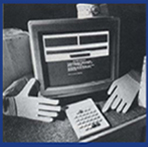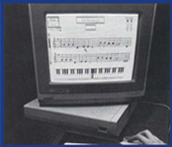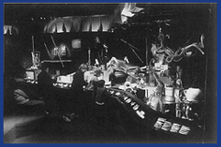 |
 |
 |
 |
 |
 |
 |
 |
 |
 |
A permanent gallery devoted to the history and technology of artificial intelligence and robotics. The exhibit presented A.I. as encompassing mental aspects of solving a problem or fulfilling a task while robots perform the physical motions required to carry out a task. The exhibit included about 400,000 lines of application code, running under 4 types of LISP, C, Basic, and Pascal, 50 robots weighing 6 tons, 25 computers, and 7 video programs. Knowledge-Based Systems: Interactive exhibits focused on such expert systems as: a medical diagnosis system; a simple rule-based simulated bargaining store-keeper with whom visitors haggled over the price of a crate of strawberries; a computer composition system; Harold Cohen's drawing expert named AARON; and a story-generating program. Natural Language Understanding: Visitors asked questions of ELIZA, the automated psychotherapist that engaged users profoundly even though it only used extremely simple response-generating rules. In an interactive video disk system, visitors dissected the computer HAL's natural language capability in an excerpt of the Stanley Kubrick film 2001: A Space Odyssey. Game Playing: Museum-goers challenged computer opponents in tic-tac-toe, five-in-a-row, and checkers, choosing a level of play and, in some instances, a strategy, e.g. look-ahead search, voting, or random. The game "How the West Was Won," taught arithmetic. Robot Sensing: Museum visitors interacted with four robot sensing modalities: vision, hearing, touch, and sonar. Vision: after arranging a set of simple shapes on a board, a vision system attempted to recognize them by using edge detection. Hearing: this was exemplified by a speech recognition system. Touch: visitors touched a pressure-sensitive pad that outputted the distribution of pressure under their figures onto a display. Sonar: a ceiling-mounted sensor measured a visitor's height by bouncing a signal off the top of the head. Robot Theater: A collection of robots were arrayed inside a theater, each of which, when highlighted in the theater's video program, lit up and, in several cases, performed movements. Mobile robots included: Shakey from Stanford Univerity, The Prototype Mars Rover, the Stanford Cart, the quadruped Titan III from the Tokyo Institute of Technology, and a Denning Mobile Robot. Robot arms included the Unimate I, the Stanford Arm, the Direct Drive Arm-1 from Carnegie Mellon University, and the Tentacle Arm from MIT. |
Opening: June 18, 1987 Square Footage: 4000 sq.ft. Cost: $500,000 Sponsors: Donors: Funding: Symbolics, Inc., Gordon Bell, Xerox Grants: Development: Oliver Strimpel, Leah Hutton, Michael Bergman, Gwen Bell, Marc LeBlanc, Michael Callahan, Steve Cummings, Joe Bates, Lynn Hall Design: Michael Sand, Inc., Ripman Lighting Consultants, WITCOM Associates Construction: Tom Merrill, Joslin Fields, Wauter Habraken, George Kfoury, Michael Oleksiw, Linda Holekamp, Mark Hunt, Kathy Keough, Kurt Levitan, Greg Schroeder, Bonnie Turrentine, Gordon Bell, Andre and Judith LeBlanc, Roger Glovsky, Patti Hillis, Laura and Victor Gregg, Steve Strassman Exhibit Advisors: Contributors: Institutions and individuals who contributed to the exhibit Smart Machines TCM Summer/Fall Report 1987 Smart Machines Enhancement TCM News Winter 1993 (Seven Video programs were developed for the exhibit) Smart Machines Theater Video Knowledge based exhibits included Quick Medical Reference (QMR), Haymarket program, Musical score follower, drawing expert AARON, TALE-SPIN program which generated stories. Language based exhibits included grammar checker, Datatalker from Natural Language, Inc., an interactive video disk system featuring HAL from 2001: A Space Odyssey, ELIZA computer psychotherapist program, and RACTER program. Game Playing exhibits featured a chess playing program, tic-tac-toe and five-in-a-row, a checker player, and a numbers game entitled "How The West Was Won". Robot Sensing included vision, hearing, touch, and sonar which included a fingerprint recognition system, pressure sensitive pad for touch sensitivity, and a ceiling mounted sensor which measured visitors' height. |
Upgraded: February 2015